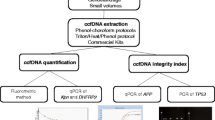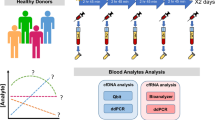Abstract
Circulatory cell-free DNA (cf-DNA) is increased in a variety of clinical pathologic conditions; therefore, these markers could be widely used as markers for detecting and monitoring several disorders. To better understand the biology of this molecule, we analysed the relationship between the level of circulatory cf-DNA and physiological parameters such as gender, age and frequency of blood donations. Paired plasma and serum samples were obtained from 87 blood donors and 50 healthy adults who had never donated blood. Cf-DNA was extracted from plasma and serum samples using the MagNA Pure LC Instrument. Quantity determination of circulatory cf-DNA was performed by TaqMan real-time PCR for the ubiquitous GAPDH gene. Our data showed that the concentration of cf-DNA in serum was about eightfold higher than that in plasma. Regarding the level of these circulatory species, no significant differences were observed between the age-matched men and women and gender-matched, different-age cohorts, except in women who were older than 60 years of age. Frequent blood donations did not increase the circulatory species. Circulatory cf-DNA in plasma and serum samples is not correlated with human gender and human age except in women who are older than 60 years of age. Frequent blood donation did not affect the quantity of circulatory cf-DNA. The explanation for the latter most likely is the short half-life time of free fetal DNA in maternal circulation.


Similar content being viewed by others
References
Boddy JL, Gal S, Malone PR, Harris AL, Wainscoat JS (2005) Prospective study of quantitation of plasma DNA levels in the diagnosis of malignant versus benign prostate disease. Clin Cancer Res 11(4):1394–1399
Gautschi O, Bigosch C, Huegli B, Jermann M, Marx A, Chasse E, Ratschiller D, Weder W, Joerger M, Betticher DC, Stahel RA, Ziegler A (2004) Circulating deoxyribonucleic acid as prognostic marker in non-small-cell lung cancer patients undergoing chemotherapy. J Clin Oncol 22(20):4157–4164
Lam NY, Rainer TH, Chan LY, Joynt GM, Lo YM (2003) Time course of early and late changes in plasma DNA in trauma patients. Clin Chem 49(8):1286–1291
Lee TH, Montalvo L, Chrebtow V, Busch MP (2001) Quantitation of genomic DNA in plasma and serum samples: higher concentrations of genomic DNA found in serum than in plasma. Transfusion 41(2):276–282
Leung TN, Zhang J, Lau TK, Chan LY, Lo YM (2001) Increased maternal plasma fetal DNA concentrations in women who eventually develop preeclampsia. Clin Chem 47(1):137–139
Chun FK, Muller I, Lange I, Friedrich MG, Erbersdobler A, Karakiewicz PI, Graefen M, Pantel K, Huland H, Schwarzenbach H (2006) Circulating tumour-associated plasma DNA represents an independent and informative predictor of prostate cancer. BJU Int 98(3):544–548
Goebel G, Zitt M, Muller HM (2005) Circulating nucleic acids in plasma or serum (CNAPS) as prognostic and predictive markers in patients with solid neoplasias. Dis Markers 21(3):105–120
Chiu TW, Young R, Chan LY, Burd A, Lo DY (2006) Plasma cf-DNA as an indicator of severity of injury in burn patients. Clin Chem Lab Med 44(1):13–17
Zhong XY, Holzgreve W, Hahn S (2002) The levels of circulatory cell-free fetal DNA in maternal plasma are elevated prior to the onset of preeclampsia. Hypertens Pregnancy 21(1):77–183
Zhong XY, Holzgreve W, Hahn S (2001) Circulatory fetal and maternal DNA in pregnancies at risk and those affected by preeclampsia. Ann N Y Acad Sci 945:138–140
Lo YM, Tein MS, Lau TK, Haines CJ, Leung TN, Poon PM, Wainscoat JS, Johnson PJ, Chang AM, Hjelm NM (1998) Quantitative analysis of fetal DNA in maternal plasma and serum: implications for noninvasive prenatal diagnosis. Am J Hum Genet 62(4):768–775
Zhong XY, Holzgreve W, Hahn S (2001) Risk free simultaneous prenatal identification of fetal Rhesus D status and gender by multiplex real-time PCR using cell-free fetal DNA in maternal plasma. Swiss Med Wkly 131(5–6):70–74
Zhong XY, Laivuori H, Livingston JC, Ylikorkala O, Sibai BM, Holzgreve W, Hahn S (2001) Elevation of both maternal and fetal extracellular circulating deoxyribonucleic acid concentrations in the plasma of pregnant women with preeclampsia. Am J Obstet Gynecol 184(3):414–419
Zhong XY, Burk MR, Troeger C, Jackson LR, Holzgreve W, Hahn S (2000) Fetal DNA in maternal plasma is elevated in pregnancies with aneuploid fetuses. Prenat Diagn 20(10):795–798
Gupta AK, Holzgreve W, Huppertz B, Malek A, Schneider H, Hahn S (2004) Detection of fetal DNA and RNA in placenta-derived syncytiotrophoblast microparticles generated in vitro. Clin Chem 50(11):2187–2190
Pachl J, Duska F, Waldauf P, Fric M, Fanta J, Zdarsky E (2005) Apoptosis as an early event in the development of multiple organ failure? Physiol Res 54(6):697–699
Plenchette S, Filomenko R, Logette E, Solier S, Buron N, Cathelin S, Solary E (2004) Analyzing markers of apoptosis in vitro. Methods Mol Biol 281:313–331
Lui YY, Chik KW, Chiu RW, Ho CY, Lam CW, Lo YM (2002) Predominant hematopoietic origin of cf-DNA in plasma and serum after gender-mismatched bone marrow transplantation. Clin Chem 48(3):421–427
Lee TH, Montalvo L, Chrebtow V, Busch MP (2001) Quantitation of genomic DNA in plasma and serum samples: higher concentrations of genomic DNA found in serum than in plasma. Transfusion 41(2):276–282
Acknowledgments
We thank Dr. Dorothy Huang for her helpful comments and for reviewing the English. We thank Dr. Paul Hasler and the University Blood Bank of Basel for providing samples.
Author information
Authors and Affiliations
Corresponding author
Rights and permissions
About this article
Cite this article
Zhong, X.Y., Hahn, S., Kiefer, V. et al. Is the quantity of circulatory cell-free DNA in human plasma and serum samples associated with gender, age and frequency of blood donations?. Ann Hematol 86, 139–143 (2007). https://doi.org/10.1007/s00277-006-0182-5
Received:
Accepted:
Published:
Issue Date:
DOI: https://doi.org/10.1007/s00277-006-0182-5




